Kem Ley, perhaps Cambodia’s most prominent political analyst and a frequent critic of Prime Minister Hun Sen, was shot dead on Sunday morning at the convenience store of a gas station where he drank coffee and met with friends most mornings.
Sitting alone inside the Caltex gas station at the intersection of Monivong and Mao Tse Toung boulevards, the 46-year-old was attacked execution-style, shot once behind his left ear and once under his left arm, according to Norng Sovannaroth, the Phnom Penh Municipal Court doctor.
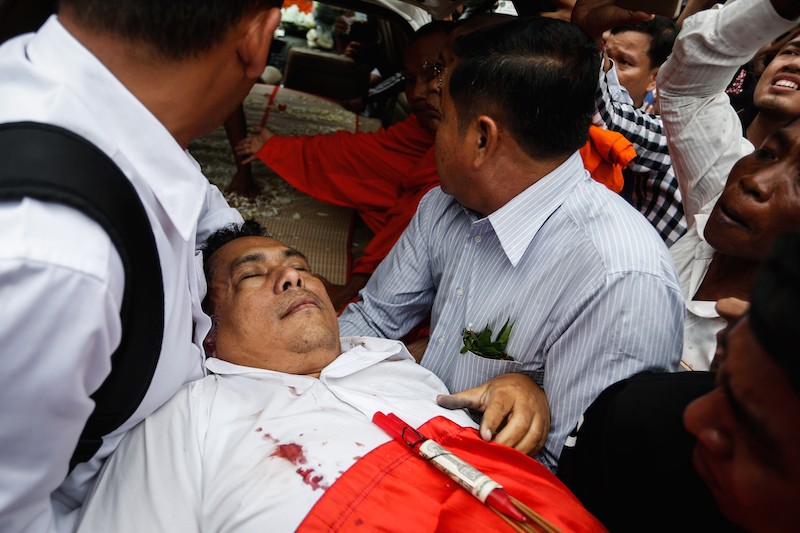
“He was shot once in the head, behind the ear, and once more on his upper arm, exiting out the right of his chest,” said Dr. Sovannaroth at about 3 p.m., after hours of inspecting the body inside the store.
The shooting occurred just after 8:30 a.m., according to officers at the scene. Gas-pump attendants said they thought the shots that killed Kem Ley were an electrical fault, with one staff member even flicking an emergency button to turn off the current.
“I heard the sound of something go ‘bang! bang!’ and I thought the coffee machine had blown up, because this morning the coffee machine was not working,” said pump attendant Sam Praseth, 25.
“The staff inside ran out and shouted, ‘Kem Ley was shot,’” he recounted. “He was just served his coffee and had not started drinking it yet.”
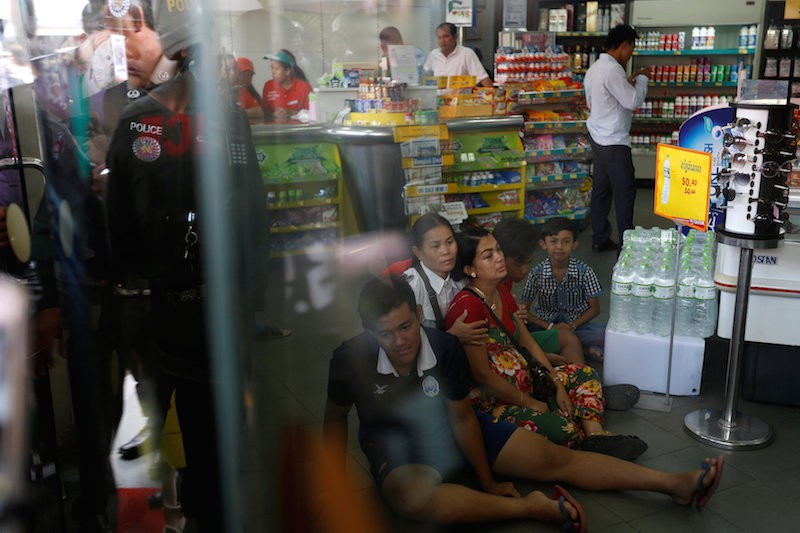
A regular customer, 25-year-old university student Leng Odom, said Kem Ley would drink coffee at the shop most mornings and often returned in the afternoon, meeting with friends for discussions about politics.
“Sometimes he had coffee alone and sat playing with his phone and reading the newspaper, and the people in the mart who knew him would come to talk to him,” Mr. Odom said. “He was a friendly person.”
Kim Ratana, a Tonle Bassac commune police officer who chased the gunman, said that an arrest was made at about 9 a.m. near Aeon Mall, approximately 1.5 km northeast of the gas station.
The Interior Ministry released a statement identifying the killer as a 38-year-old Cambodian man who often worked in western Thailand.
“After the arrest, the attacker confessed that his name is ‘Chuob Samlab,’” it said, adding that he did farm work in Thailand’s Sa Kaeo province. “Chuob Samlab” translates as “Meet Kill.”
“This name, we can’t believe it,” said Phnom Penh municipal police chief Chuon Sovann at a press conference in the afternoon. “For a long time, people have never given the name ‘samlab’ to children.”
General Sovann said the gunman had shot Kem Ley from a position “about two steps away” and was now being detained at the municipal police headquarters. The investigation would now focus on whether someone else had directed the murder, he said.
“The evidence we confiscated from the perpetrator clearly shows this perpetrator is the killer that shot Dr. Kem Ley to death,” Gen. Sovann said.
A 35-second video of the suspect confessing—the left side of his face and chest covered in blood—was posted on the Fresh News website in the afternoon. The man claims he purchased a pistol while in Thailand in order to kill Kem Ley over a debt that had gone unpaid for more than year.
“We used to meet,” the man is seen replying when asked how he knew Kem Ley. “He borrowed it to help villagers,” he adds of the $3,000 that he says he loaned to the analyst.
Yet few among the roughly 2,000 people who turned out around the gas station on Sunday believed this account of the execution, with some blaming Mr. Hun Sen for the killing and others simply shouting: “I don’t believe it.”
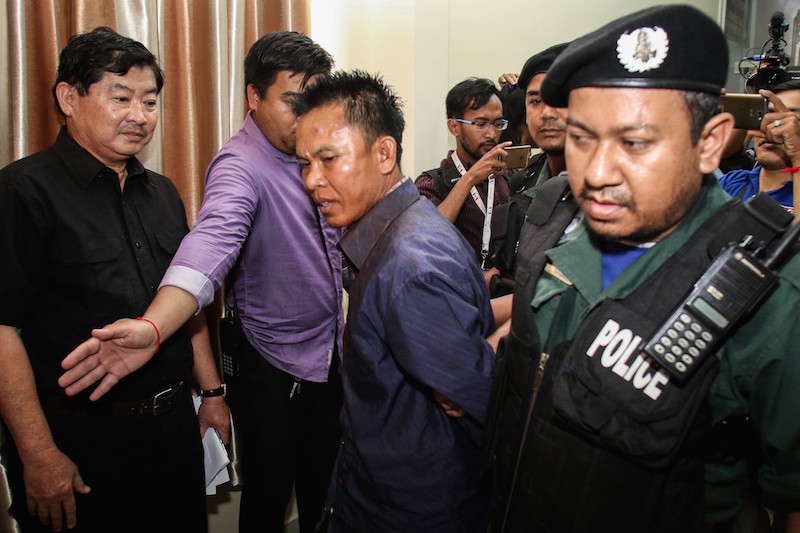
Moeun Tola, one of Kem Ley’s close friends and himself an outspoken critic of the government as head of labor rights group Central, said outside the gas station that anyone who had wanted to plan the analyst’s killing would have known where to find him.
“He came here every day to drink coffee and to meet people, unless he was in the provinces on a mission,” said Mr. Tola, rejecting the idea that his friend was killed in broad daylight due to an unpaid debt.
“It’s ridiculous. This is related to the political issues. He was a very outspoken critic of the government. Only two days ago, he was on Radio Free Asia and was talking about the Global Witness report,” he said.
The report, which details the vast business holdings of Mr. Hun Sen’s family, drew a fierce rebuke from the premier’s family last week. Kem Ley had said it was a bad situation but that Mr. Hun Sen had little to worry about.
“It’s a conflict of interest,” he said on a Radio Free Asia program on Friday night, adding that the report showed how completely Mr. Hun Sen’s family controlled both the private and public sides of Cambodian society.
“One is the one who signs, and the other is the one who approves,” he said. “The head of the Anti-Corruption Unit reports directly to the prime minister, and if it found the family in this situation, 100 percent, it would not dare investigate.”
However, despite the claims from some in the crowd that the killing was a political murder following the pattern of many in the past, Mr. Hun Sen was quick to condemn the killing on his Facebook page.
“I would like to join in the mourning of the death of Kem Ley, who was cruelly killed by a gunman, which I condemn as a savage act,” Mr. Hun Sen wrote, calling for a complete investigation. The CPP, too, issued a statement sharing condolences.
Police efforts to remove Kem Ley’s body from the gas station shop were repeatedly hampered by the crowd of onlookers, with many concerned the police were attempting to engage in a cover-up by trying to shutter the gas station’s windows and then rush his body out.
Upon the arrival of an ambulance marked with the logo of the Cambodian Red Cross (CRC)—a group run by Mr. Hun Sen’s wife—many in the crowd shouted, “It’s the car of the killer,” and demanded to carry his body to a pagoda.
Both the CRC ambulance and a separate private ambulance, which the crowd pelted with plastic bottles, were prevented from taking Kem Ley’s body away, with the crowd growing to about 5,000 in the afternoon.
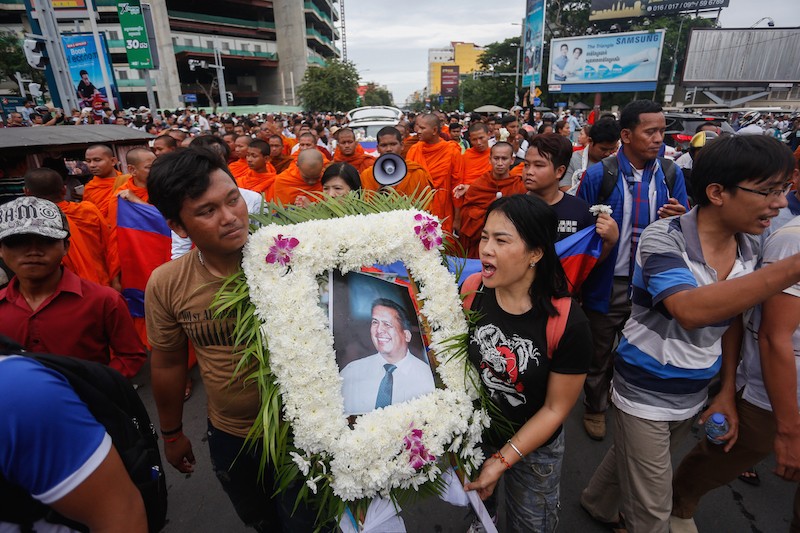
When authorities allowed Kem Ley’s body to be placed into the SUV he arrived in, the crowd began to cooperate. Covered in a Cambodian flag, his body was placed in the back of his vehicle at about 3 p.m., beginning an hourslong procession through Phnom Penh to Wat Chas pagoda, where his body was laid down and surrounded by mourners through the evening.
Kem Ley leaves behind his wife, who is five months pregnant, as well as four sons. He had in recent weeks proudly gathered them together clad in black for photographs in support of the “Black Monday” campaign to free imprisoned human rights activists.
Suon Bunsak, secretary-general of the Cambodian Human Rights Action Committee, said the loss of Kem Ley was huge, as the commentator had filled a vital role of explaining—often on the radio—the story behind the machinations of Cambodian politics, making issues accessible to wider audiences.
“It’s a loss to Cambodia’s human resources because he had the knowledge to talk about the general processes of the state’s rule, as well as other social matters,” Mr. Bunsak said.
“It’s difficult for us to find such a person…so the loss of Kem Ley is a big loss.”
Mr. Bunsak added that he, like Kem Ley, had long taken pride in not being afraid of threats for advocating rights in Cambodia, but that after Sunday: “I would like to admit that I am scared.”
Kem Ley was never afraid of criticizing figures on both sides of the political divide and often came under fire from the opposition CNRP, with some officials protesting that he was preparing for his own political run by criticizing the party for not being truly democratic.
His frustration with the political status quo led the analyst to last year direct the creation of the Grassroots Democracy Party—an effort to put control of a party in the hands of its members—before leaving it and returning to commentating on politics and traveling around the country for meetings and lectures.
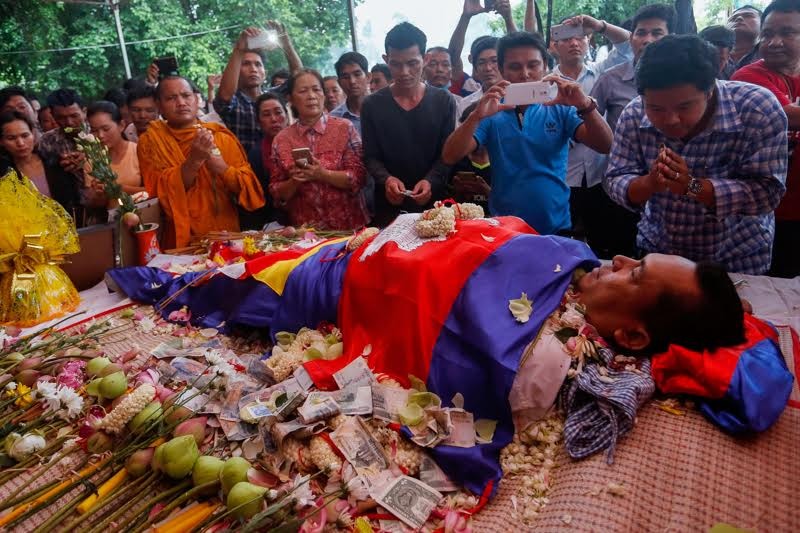
Kem Ley’s body is laid at the Wat Chas pagoda in Phnom Penh after he was shot dead at a gas station earlier in the day. (Siv Channa/The Cambodia Daily)
Among analysts, Kem Ley also had one of the most optimistic outlooks for Cambodia’s future, often mixing his criticism with messages of hope founded in the increased political confidence among the public in the age of the internet.
“People were scared 10 years, maybe three years ago, but right now they are fully immune to fear,” Mr. Ley said in an interview in May, when asked about the impact of about two dozen ruling party critics being jailed over the previous year.
“Even me. I’m more confident about being outspoken and criticizing in a fair manner.”
(Additional reporting by Khuon Narim and Kim Chan)



